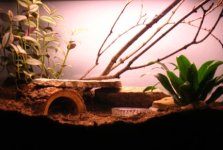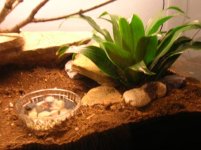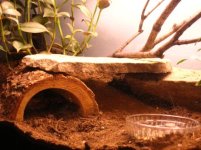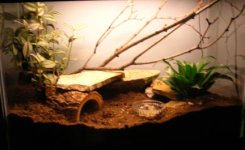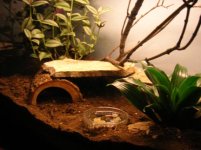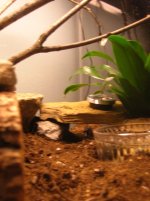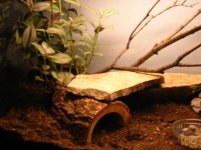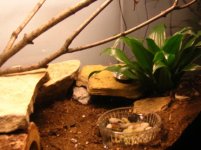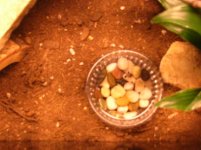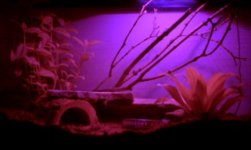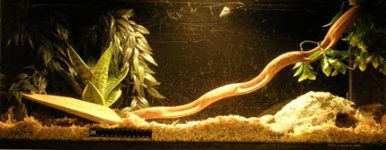Bioactive substrate (BAS) - a why and “how-to” guide.
Many folks have messaged me for instructions and updates, and compliment, (Thank You ) so I thought I’d start this thread and maybe intrigue a few to try it with some clear, to the point instructions whist updating you periodically with my observations.
I’ll start with
The reasons I went with this type of setup (in no specific order):
Practical:- I read the book: “The Art of Keeping Snakes” by Philippe de Vosjoli and he made some convincing scientific and practical arguments for such a setup backed with detailed observations.
- I don’t have many snakes. If I were a breeder or had lots of snakes, this would require a huge amount of room so I am not knocking those with simple setups. The book suggests a bioactive ROOM if you are a breeder and not many of us have that kind of extra space.
- Suits my needs for an indoor garden.
- enhances the life of he snake (see below) and therefore reduces my guilt for holding an animal captive.
IMO more easily maintained:
- requires only weekly maintainence of watering and stirring, and wiping the glass;
- requires same scooping out of poop as other substrates;
- requires the additional of more substrate mixture only as needed (compaction will guide you as the substrate is visible through the glass)
- biological creatures do the “cleaning” work for you and the coco peat added is a natural odor absorber and it doesn’t smell so...
- I don’t have to tear the whole thing apart and clean out the bottom, etc.
more attractive:
- looks great in the living room and can double as a light;
- more attractive and and sculptural; when snake is hiding,
- I have a lovely, natural looking indoor garden to look at when snakie is sleeping.
offers a variety of options and visceral experiences for the snake:
- “play” and roaming room for the snakes is increased as multiple levels means increased floor space. A small vivARium becomes larger;
- offers variety in textures, scents, levels, temperature gradients, humidity gradients, places to rest, places to hide, ways to try to escape! LOCK THE LID or weigh it down good!
- hopefully, it’s closer to a natural environment and snakie feels less stressed.
shedding and moisture/humidity is better and more easily maintained- snake can burrow for moisture when needed during a shed. (no additional moisture box needed) Her sheds are complete now.
- only the very “more compacted bottom inch is “wet” and the snake doesn’t go down that far so skin diseases are not an issue as moisture is not next to the skin constantly.
- the dirt, once bioactive, doesn’t stick to the snake and seems to shine up her scales more than aspen did.
- requires I mist daily, same as other setups.
encourages a wider range of behaviors and exercise for the snake, and subsequent opportunities for my viewing pleasure.
- the snake can, and mine does, climb all over everything: branches, rocks, burrows in the dirt, wiggles around on the plants, sleeps around the stems during the day, climbs to the highest branches at the screen top at night.
- roams at night A LOT and now across the vivARium rather than just the outside perimeter.
- The snake also gets herself into some tricky situations where she has to figure out how to get back down to the ground (off the higher smaller branches). Perhaps these challenges keep her on her toes... Hey wait a minute...
Next installment to come: What you’ll need to get:
Many folks have messaged me for instructions and updates, and compliment, (Thank You ) so I thought I’d start this thread and maybe intrigue a few to try it with some clear, to the point instructions whist updating you periodically with my observations.
I’ll start with
The reasons I went with this type of setup (in no specific order):
Practical:- I read the book: “The Art of Keeping Snakes” by Philippe de Vosjoli and he made some convincing scientific and practical arguments for such a setup backed with detailed observations.
- I don’t have many snakes. If I were a breeder or had lots of snakes, this would require a huge amount of room so I am not knocking those with simple setups. The book suggests a bioactive ROOM if you are a breeder and not many of us have that kind of extra space.
- Suits my needs for an indoor garden.
- enhances the life of he snake (see below) and therefore reduces my guilt for holding an animal captive.
IMO more easily maintained:
- requires only weekly maintainence of watering and stirring, and wiping the glass;
- requires same scooping out of poop as other substrates;
- requires the additional of more substrate mixture only as needed (compaction will guide you as the substrate is visible through the glass)
- biological creatures do the “cleaning” work for you and the coco peat added is a natural odor absorber and it doesn’t smell so...
- I don’t have to tear the whole thing apart and clean out the bottom, etc.
more attractive:
- looks great in the living room and can double as a light;
- more attractive and and sculptural; when snake is hiding,
- I have a lovely, natural looking indoor garden to look at when snakie is sleeping.
offers a variety of options and visceral experiences for the snake:
- “play” and roaming room for the snakes is increased as multiple levels means increased floor space. A small vivARium becomes larger;
- offers variety in textures, scents, levels, temperature gradients, humidity gradients, places to rest, places to hide, ways to try to escape! LOCK THE LID or weigh it down good!
- hopefully, it’s closer to a natural environment and snakie feels less stressed.
shedding and moisture/humidity is better and more easily maintained- snake can burrow for moisture when needed during a shed. (no additional moisture box needed) Her sheds are complete now.
- only the very “more compacted bottom inch is “wet” and the snake doesn’t go down that far so skin diseases are not an issue as moisture is not next to the skin constantly.
- the dirt, once bioactive, doesn’t stick to the snake and seems to shine up her scales more than aspen did.
- requires I mist daily, same as other setups.
encourages a wider range of behaviors and exercise for the snake, and subsequent opportunities for my viewing pleasure.
- the snake can, and mine does, climb all over everything: branches, rocks, burrows in the dirt, wiggles around on the plants, sleeps around the stems during the day, climbs to the highest branches at the screen top at night.
- roams at night A LOT and now across the vivARium rather than just the outside perimeter.
- The snake also gets herself into some tricky situations where she has to figure out how to get back down to the ground (off the higher smaller branches). Perhaps these challenges keep her on her toes... Hey wait a minute...
Next installment to come: What you’ll need to get:

